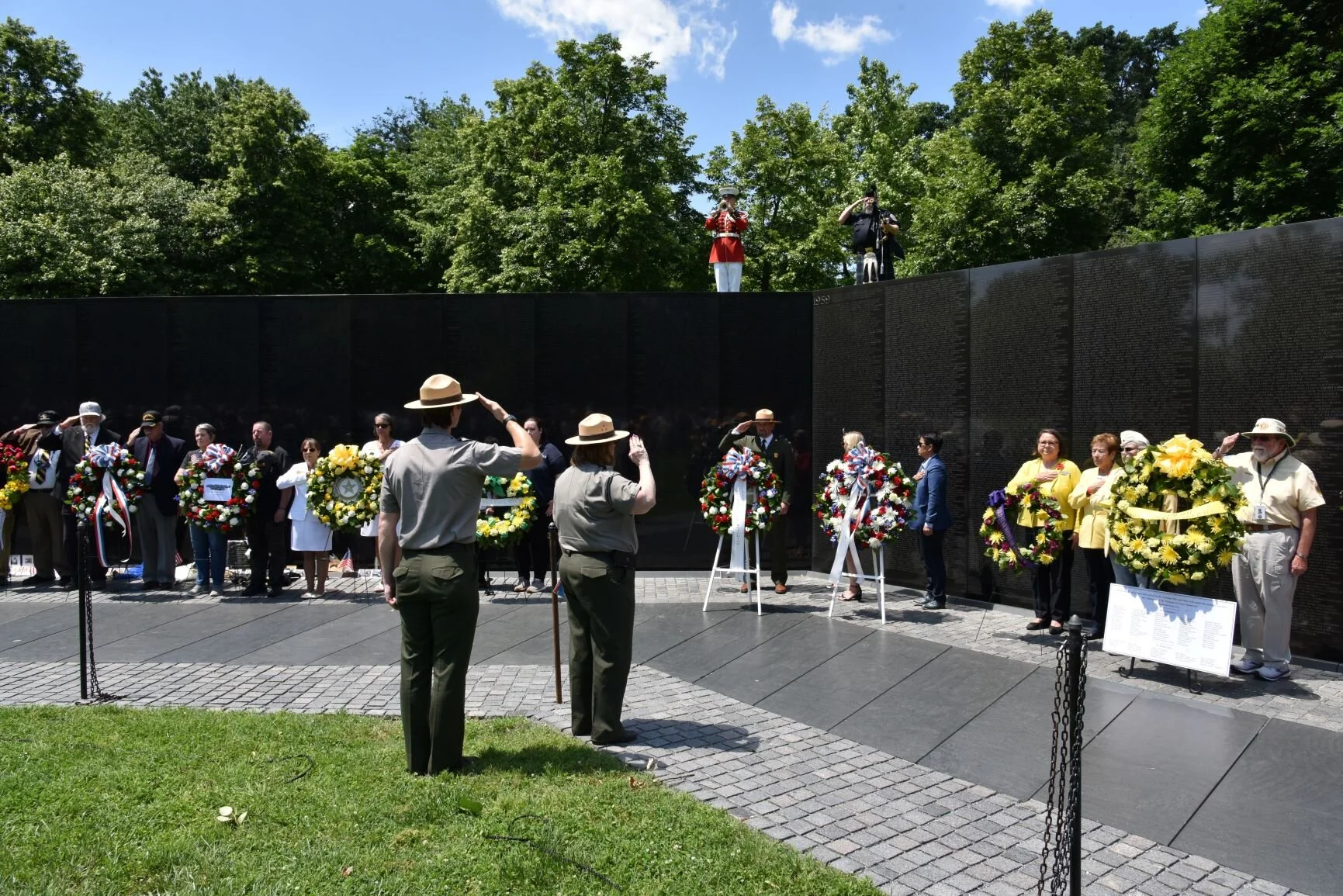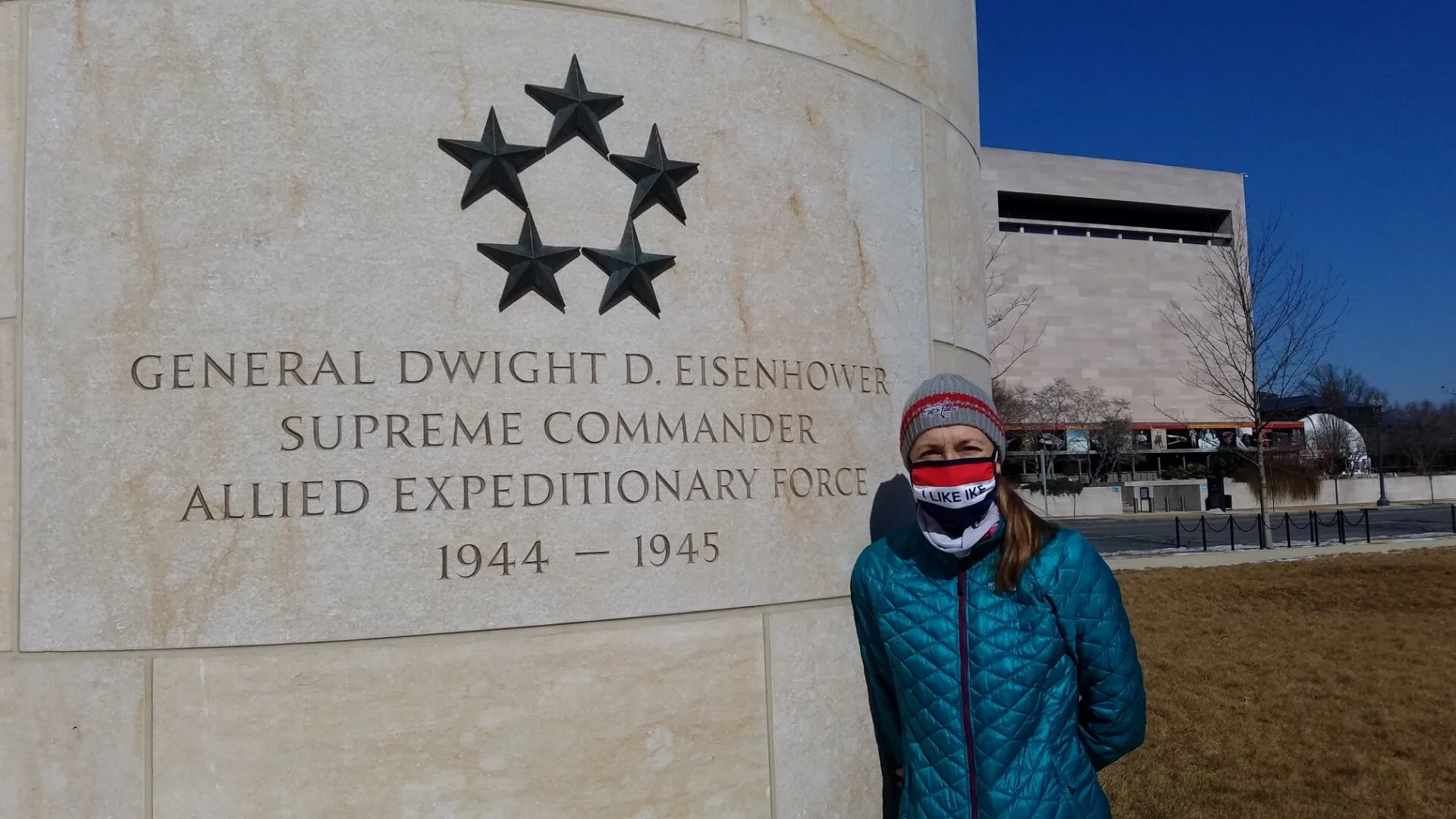Voices of Volunteers: Candace Harman
Voices of Volunteers: Candace Harman
In celebration of Women's History Month, we are sharing the stories of some of the amazing women on the National Mall - our volunteers! With their unique backgrounds and perspectives, they enliven the National Mall and enrich visitors' experiences. These women share why they volunteer, what the experience means to them, and highlight some of the women who inspire them, both on and off the Mall!
Candace Harman joined the volunteer corps in 2017 and has served at the Lincoln Memorial, Washington Monument, Korean War Veterans Memorial, and World War II Memorial. Candace has been volunteering at the Eisenhower Memorial since it opened in September 2020, after her trip to Normandy inspired a new appreciation for Eisenhower’s leadership during World War II. Candace has a long history with the National Mall, as she worked there as a seasonal Park Ranger at the beginning of her career.
Trust for the National Mall (TNM): The National Mall encompasses stories of many inspiring women, such as our First Ladies, those who marched for Women's Rights, the heroes represented in the Vietnam Women’s Memorial, icons such as Marian Anderson, and the founders of the National Woman’s Party. What women of the National Mall inspire you? What does it mean to you to volunteer amongst these legacies?
Candace Harman (CH): There are several women of the National Mall who inspire me, but there are two stories that stick out to me.
At the young age of 21, while an undergraduate at Yale University, Maya Lin had the confidence to submit a design in the nationwide competition for the Vietnam Veteran’s Memorial and the courage to defend it despite severe adversity. Her nontraditional design, one of 1,422 submissions, was selected as the winner. The design was initially controversial because of the lack of resolution of the national conflicts over the war, conflicting opinions over what constituted an appropriate, modern day memorial, Lin’s Asian ethnicity (though she was born in Athens, Ohio, and a citizen of the United States), and her lack of professional experience. Though inexperienced, Lin was not deterred by the naysayers and successfully defended her design before Congress. Today, the Vietnam Veteran’s Memorial is considered one of the most recognizable and influential designs of the post-World War II period.
I am also eternally grateful to those who fought for women’s right to vote, especially those who marched on Pennsylvania Ave on March 3, 1913. The procession, meticulously orchestrated by Alice Paul and Lucy Burns with the National American Suffrage Association, called attention to women’s exclusion from the democratic process.
The demonstration was designed to showcase the accomplishments of women in the nation and around the world. Led by Inez Milholland who rode a white horse named Grey Dawn, the protest included marchers, bands, and floats. These courageous women, who found themselves trapped in a sea of hostile, jeering men yelling vile and vulgar insults at them, were manhandled and spat upon while nearby police officers either paid them little attention or admonished that if they had stayed home they would not be in this predicament. Although a few women fled the terrifying scene, most were determined to continue. They locked arms and pushed forward, some through tears. They tried to ignore the taunts, and some brandished banner poles, flags, and hatpins to ward off attack. They held their ground until the U.S. Army troops arrived about an hour later to clear the street so that the procession could continue.
Being able to volunteer on the National Mall amongst these legacies is something I treasure. As I continue to learn more about these heroines, I have even more gratitude for the sacrifices they made for all of us. I hope I can share these messages with those who visit the National Mall.
TNM: What women in your own life inspire you?
CH: Two women in my own life who inspired me are my mother and Liz Madison, an internship supervisor I had while in college at the University of Idaho. I would not be where I am today without the love, support, and encouragement of both women.
My mother always encouraged me to do my best. She emphasized the importance of college education and to be as prepared as possible for what life may throw at me. Also, she strikes the difficult balance between being nonjudgmental and providing redirection when needed. It was her advice that helped me decide to go to college and to finish as well as her encouragement that I could be successful in graduate school when I pursued an MBA.
Liz Madison was my supervisor for my internship while in college at the University of Idaho. She is smart, hardworking, and kind. She saw my potential, encouraged me to develop my talents, provided direct feedback and correction when I needed it, and introduced me to the National Mall by encouraging me to apply as a Seasonal Park Ranger, and I would not be here today if she had not done so.
TNM: What can we learn from the women in Eisenhower’s life or administration?
CH: I have learned some valuable lessons from two women in Eisenhower’s life, his mother, Ida, and his wife, Mamie.
Ida Stover Eisenhower encouraged Dwight to think independently and to make his own decisions even if she did not agree with them. There are two examples from his childhood that illustrate this: when he developed a leg infection as a child and his career in the military. Ike developed an infection in his leg when he was a freshman in high school. The doctor insisted that the leg be amputated, but Ike stopped it saying, “I’d rather be dead than…not able to play ball.” His parents honored this decision. Miraculously, he got better.
Ida’s reaction to Ike’s career is a second example of her character. She was a life-long pacifist, so Dwight’s decision to attend West Point saddened her. She felt that warfare was “rather wicked” but did not overrule him. When he was accepted to West Point, his peace-loving mother quietly told him, "It's your choice.” It was only when he was on his way to the academy that she finally broke down and cried. Over time she learned to accept her son’s career.
Two of Mamie Eisenhower’s traits that impress me are how personable and genuine she was and the devotion she had for her husband.
The President called Mamie “my invaluable, my indispensable, but publicly inarticulate lifelong partner.” She lived an extraordinary life, yet she was like millions of American women who gave priority to home and family. She said, “I had a career. His name was Ike.” It was normal in the 1950s that married women concentrated on their roles as wives, mothers, and homemakers. Mrs. Eisenhower did just that. She was the nation’s most prominent, well dressed “Hostess in Chief” and made sure that the White House was a comfortable home.
Though she had a comfortable upbringing, Mamie learned how to manage a household on a tight budget after she married Dwight. She was known as a penny pincher who clipped coupons for the White House staff. She insisted that everybody who wrote to her should get some sort of personal reply. Determinedly nonpartisan, Mamie published an article in Good Housekeeping in 1952 that she titled, “Vote for my husband or for Governor Stevenson, but Please Vote.”
It was clear that Mrs. Eisenhower was completely devoted to her husband. During World War II, Eisenhower lived in Washington, D.C. while her husband commanded troops overseas. Though she felt incredibly isolated while they were apart, she worked with other Army wives at the Red Cross canteen in Washington, D.C. During this time, she wrote to her husband nearly every day.
In the White House, she made sure there was clear separation between home and office and that the President had ample time for relaxation. Ike was an amateur artist, so she ensured he had a room to escape to his easel and paintbrush. In their family quarters the Eisenhowers spent many evenings like other couples in the 1950s: eating dinner on snack trays while watching popular television programs such as I Love Lucy.
Mamie famously supported the president through a series of health scares, which included a serious heart attack in 1955, an abdominal operation in 1956 and a stroke the following year. She encouraged him to run for a second term in 1956 because she feared retirement might be deadly for him.
TNM: What have been your experiences with the volunteer community?
CH: What a gift to be able to volunteer during the pandemic. I have volunteered on the National Mall for just over 3 years and have met some of the friendliest, most helpful people during this time. Prior to 2020, I spent most of my time at the Lincoln Memorial as well as at the Washington Monument. I especially treasure the friendships I have made with the Park Rangers, Shop Managers, and Volunteers at the Eisenhower Memorial during this difficult time. I truly look forward to seeing them each week as I volunteer.
Becoming a volunteer was very nostalgic for me. I was a seasonal Park Ranger on the Mall several years (er, decades!) ago. That experience not only established a strong foundation for my career, but it also helped me appreciate history.
TNM: What have you accomplished or learned through your volunteer position, personally, professionally, or otherwise?
CH: Establishing a foundation on visitor experience early in my career is directly related to the success I have experienced professionally in developing digital technology, where understanding user needs is critical to success. Volunteering has also given me a much greater appreciation for history. I did not take history classes in college because I did not think I liked it. It turns out I was wrong. I was just learning about it in the wrong way.
TNM: Why did you start volunteering at the Dwight D. Eisenhower Memorial?
CH: I fell in love with Normandy when I visited in June 2019 and was very excited when the Memorial opened in September. I am so grateful for to this opportunity when there are so few opportunities available during Covid.
TNM: What visitor interactions have stood out to you during your time volunteering?
CH: One memorable moment was talking with a visitor whose father worked with Eisenhower during his Administration. I think she gave a much better talk about his administration than I could have. Not only did she love the design of the Memorial, but she was in tears because of the emotional connection to the memory of her father.
Another moment is when a visitor did not appear to be pleased with the Memorial. I approached him, and he was very critical of the quotes that were selected. I suggested he walk behind the sculptures and come back and find me. He did and then told me how much he loved the Memorial, specifically because of the quotes that were selected. He left smiling.
TNM: What would you say to someone considering volunteering with the National Mall?
CH: Don’t hesitate to sign up! You will get to work with incredibly knowledgeable people and meet visitors from all over the world in one of the coolest places on earth.










